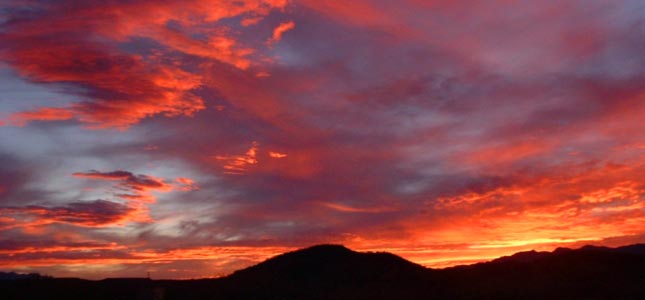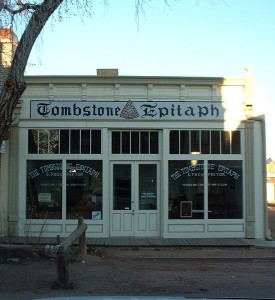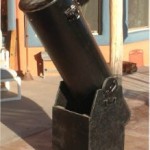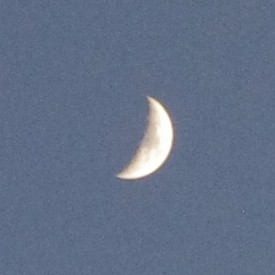Enjoy the dark skies in Cochise County at a stargazing b and b
Cochise County is known for the dark skies we enjoy at night and our stargazing b and b is in one of the better parts of the County with easy highway access. We are away from the light sources in Sierra Vista, Douglas and Tucson. Part of the reason that Cochise County is so dark is the strict light ordinance that has been enacted to prevent light pollution, thus enhancing the efficiency of the large observatories in the area. It also benefits stargazing b and b inns and allows us to offer another attraction for our guests. When we first opened Down By The River B and B, another stargazing b and b was located not far away in Benson. The world famous Skywatchers Inn was started and run by the Vegas for many years. It was finally sold around 2007 when Mrs. Vega finally retired. We still have guests ask about this inn. The b and b then became the Astronomers Inn and when that stargazing b and b finally closed in 2008 it sat unused for over a year. In 2010, the San Pedro Valley Observatory began business strictly as an astronomical observatory, research and teaching center. I wrote a blog about this in October of 2010. Down By The River has partnered with the owners of SPVO and if you make a reservation with them for star viewing, we offer a 10% discount of off the room rate when you stay at our San Pedro River B and B. Because stargazers have late hours, we work around their schedule for breakfast.
As a stargazing b and b, Down By The River is set up more for the novice astronomer who wishes to view the stars and planets but not for the serious astronomer into astrophotography. We can see deep space objects but with the higher magnification your viewing time is diminished because of the smaller field of view. A Dobsonian telescope isn’t motorized and there is no computer to do the sighting for you although we do have a finder on the scope. A Dobsonian telescope is manual in all respects and you have to aim it at what you are going to view. That doesn’t mean at our stargazing b and b you won’t see neat things but you can’t spend a long time looking at an object without readjusting the location of the telescope to view the object. It also depends on the area of the sky that you are viewing. Closer to the equator the view changes faster than when you view toward the pole star.
In April of this year, we did see the PanStarr comet just after sunset and we set the telescope for our guests and let them view it. We also showed them Jupiter with 3 moons on one night and 4 the next, open star clusters, globular clusters, some nebulae and the Andromeda Galaxy. The moon is another object to look at when it is a crescent. Full moons do not have the details of the craters visible because of the brightness. Viewing of the heavens is also dependent upon the phase of the moon. When the moon is approaching full phase the sky gets washed out with light and only some of the planets that are up and some stars will be available for viewing. Uranus, Neptune and Pluto can be seen only with dark skies.
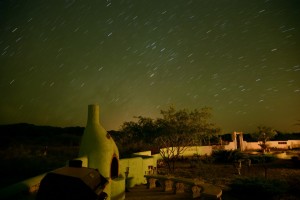
This is the first attempt with filming on a digital camera and done at the B and B on the back patio using starstax program.
But I have talked enough of the telescopes, so on with a different part of the story. You can see many things with binoculars because of the dark skies. We had a gentleman here from Hamilton, Ontario Canada who is an amateur astronomer and a camera buff. He was here at a conference and then took time to vacation in Arizona. He originally was looking for the Astronomers Inn stargazing b and b but as I said they no longer exists, He found SPVO and found that they weren’t a b and b anymore but they did refer him to us. Our guest David Galbraith introduced Angie and myself to night star photography using a tripod. David did a short star track photograph with his digital camera that included about 30 different pictures at the rear patio area. Each picture was exposed for a few seconds with a 30 second delay and then another shot. After repeatedly doing this he ended up with a collection of photos where each shot was at the same focal point but the stars moved slightly. He had a software program that would stack each photo and make it into a single photo. The program would then connect the star streaks and fill in the blackness with the appropriate starlight color. The result was a sweeping star track across the sky with the b and b in the background. You can also see some other streaks in the pictures and those are airplanes that are flying through the picture. This gives some interesting things to look at. You will also see an instance where a satellite is seen in one of the pictures.
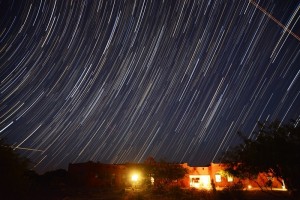
Over 100 pictures ere taken in over an hour and put together to produce this image. Not that the B and B lights do not wash out the picture.
The old 35 mm film cameras would not be able to do this is such a spectacular fashion if you had some external light sources in view. Film cameras would open the shutter continuously and stationary light sources, such as inside lighting from the b and b, would have increased over time and would have become very bright. The program averages the light at fixed sources between each frame. This keeps the picture from over exposing the brighter lights in that area. After he showed me the beginning shots and the final product, I was hooked on trying it myself. He showed me the program and how it worked. He told me it was a free program that you can download from the internet. It is called Starstax. I think it could be used for other things also, such as street scenes with cars driving through the city, lightning storms or on a whimsy tracking fireflies. While he was here he gave me copies of 3 pictures that he took around the B and B. I have included them on this blog and we thank David for his generosity for sharing them with us.
We also spent some time to take some pictures of Mercury, Venus and Jupiter just after sunset. For future reference, I played with the aperture, exposure time and speed to see which was better with my camera and these conditions. Some pictures came out brighter and some darker than others so I was pleased with the experiment. The planets were all aligned at this time and you could get the picture in a single frame. Venus became visible first and then Jupiter closely followed by Mercury. Venus was very bright and you could not really notice with the naked eye that it was waning. When I enlarged the photo on the computer, it did show the shadow side of the planet Venus. We are glad we have the opportunity to be a stargazing b and b, it adds one more dimension to all the activities that guest can enjoy here along the San Pedro River at our B and B, the Lodging Hub of Cochise County. Consider joining us to see what we have to offer with the quiet solitude of our b and bs location.
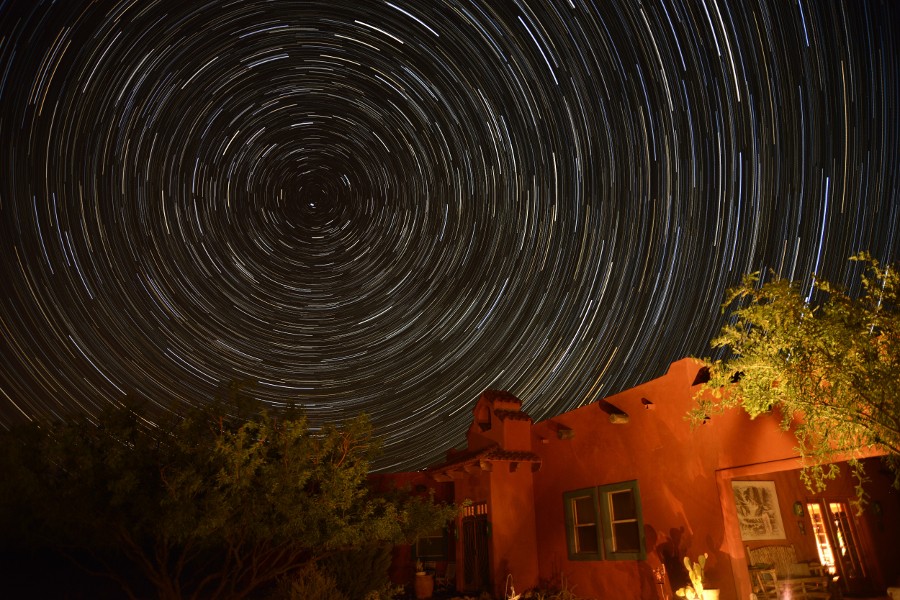
The picture is focused on the north star and shows that Polaris, the bright streak near the center, is not really due north but is offset slightly.
Tags: stargazing b and b

